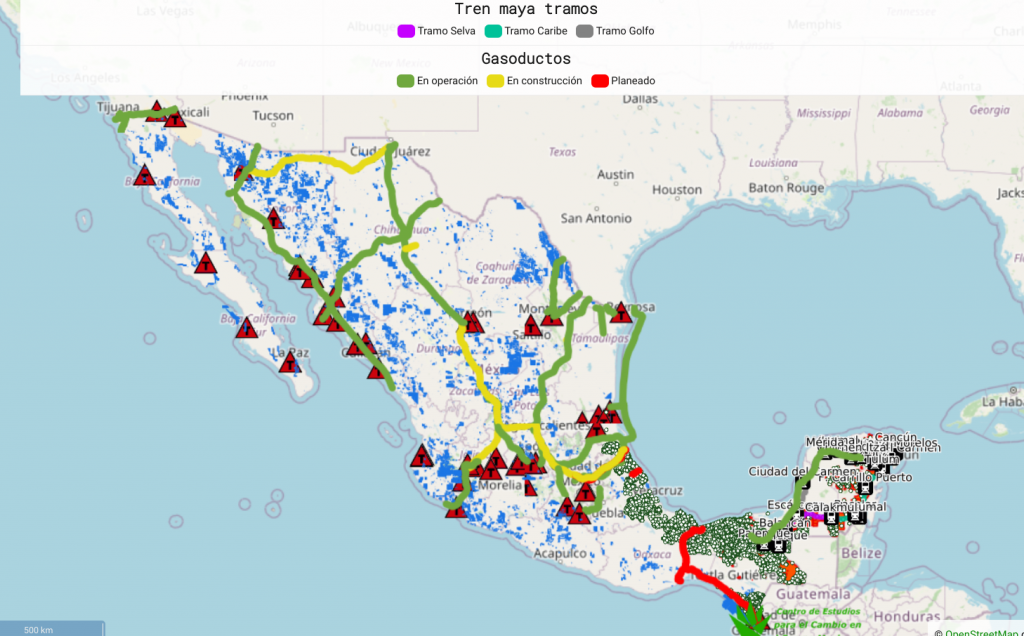Raúl Romero*

Visualize a map of México. To the north, place the Logistical and Industrial Corridor of the Treaty between México, the United States and Canada. Though the public information to the effect is still scarce and imprecise, Caxxor Group has already reported that it seeks to build and modernize ports, industrial parks, and a railroad as part of this corredor. The port of Mazatlán, in Sinaloa will be converted into a node that links the coast of Asia with that of Mexico. The information is complemented by the plans announced for the merger between the Canadian Pacific Railway and Kansas City Southern, which foresee connecting Canada, the United States and the Mexican cities of Matamoros, Monterrey, Mexico City and Veracruz, among others with 32 thousand kilometers of railway .
Now, on the same map that you are visualizing, place the Morelos Integral Project, which entails a gas pipeline, an aqueduct, and two thermoelectric plants in the middle of the volcanic axis, in the states of Puebla, Morelos and Tlaxcala. Also in the center of the country, throw in the Felipe Ángeles International Airport.
Without forgetting the above, now look at the south and the southeast of the country. In the states of Oaxaca and Veracruz, locate a train, a freeway and two ports as part of the InterOceanic Corridor which aims to connect the Pacific Ocean with the Atlantic Ocean by land. Very close to there, right next to Veracruz, also site the new refinery in Dos Bocas, in Tabasco. Don’t forget to outline the Mayan Train, with its highways and airport, in Chiapas, Yucatán, Quintana Roo and Tabasco.
Around all of these projects and megaprojects visualize the effects of the construction or modernization, as well as the operation, of hotels, bars, restaurants, wind farms, mines, pig farms, breweries, maquilas, industrial corridors, automotive plants, energy companies and much more.
On that same map, now identify the organized crime groups, those with a national presence, such as the Sinaloa Cartel and the Jalisco New Generation, or those with state or regional presence, such as the Zetas, Gulf, Caballeros Templarios, Familia Michoacana, Santa Rosa de Lima, Unión Tepito, Los Rojos, Los Ardillos…
In this same geography, you can identify the more than 4 thousand 806 clandestine graves which, in October of 2021, Karla Quintana, Commissioner for National Search for Missing Persons reported to be found in practically the entire nation, with the exception of Querétaro and Mexico City (https://bit.ly/3KI9U4S). Include also the figures from the National Registry of Missing or Unaccounted For Persons: 97, 306 people throughout México. In particular, highlight Jalisco, Tamaulipas, and the state of Mexico, where the highest number of cases are registered. Put on this same map the more than 43 journalists, both men and women, assassinated, and recognized by the Secretary of the Interior, between 2018 and July 2021. (https://bit.ly/3o7JXSD). Add to this the six journalists that have been assassinated since then, including Margarito Martínez and Lourdes Maldonado.
In this cartography of war, find also the more than 68 defenders of human rights assassinated since December of 2018 as well, the majority of them, defenders of territory. In addition, include the femicides and transfemicide.
If you want to see greater detail in the map, also put a prison city for the migrants in Tapachula, or the regions with a presence of paramilitary and narco paramilitary groups that every week attack the communities, like in Nuevo San Gregorio, in Zapatista Chiapas or in the Montaña Baja of Guerrero1. You can also mark the states where politicians have been denounced for their collaboration with extractive industry or organized crime. Or those where fresh water reserves are plundered or contaminated or where there are forests being cut down..
The neoliberal capitalism that in Mexico has reached its most representative expressions in the infrastructure, energetic and extractive megaprojects, as well as in the criminal economies, is not only the legacy of the past, but rather continues in force and expanding.
If you, as I did, felt desperation after sketching this map, you are right — things are not going well, and we should not fool ourselves. But don’t forget, that also in these same geographies, we can outline a map of resistance and of hope. More on that in our next installment.
* Sociólogist
This article was published in La Jornada on Sunday, February 6th, 2022. https://www.jornada.com.mx/2022/02/06/opinion/013a2pol English translation by Schools for Chiapas.
